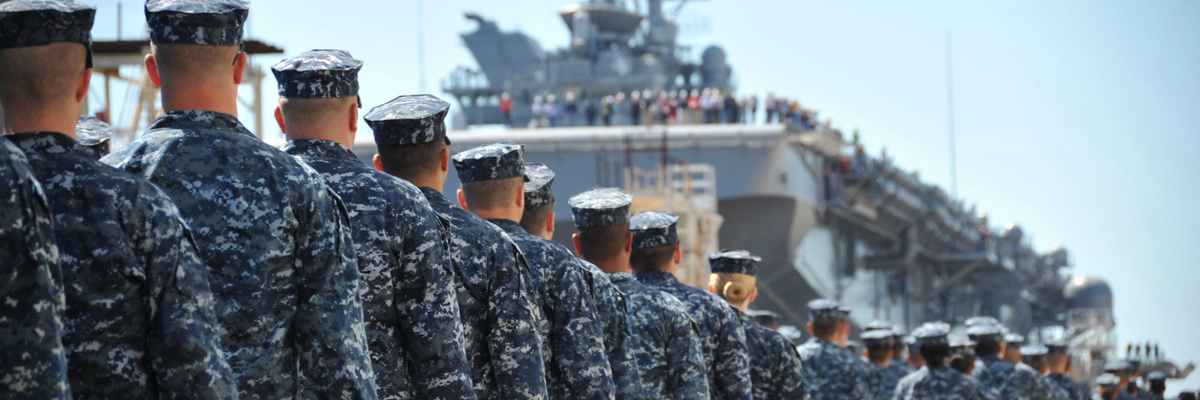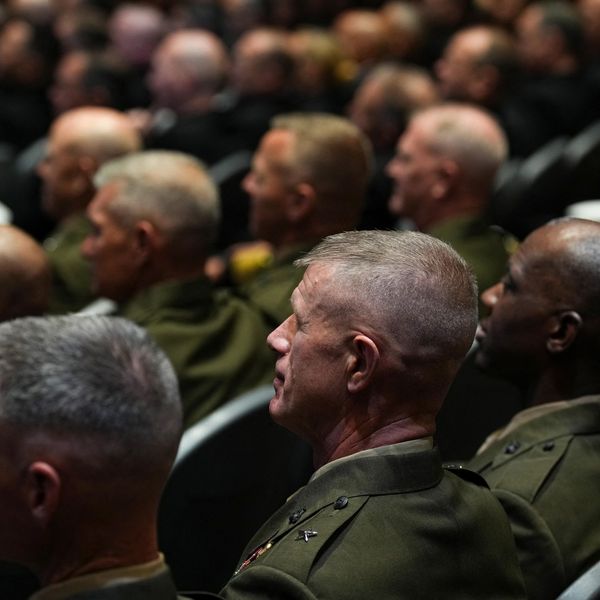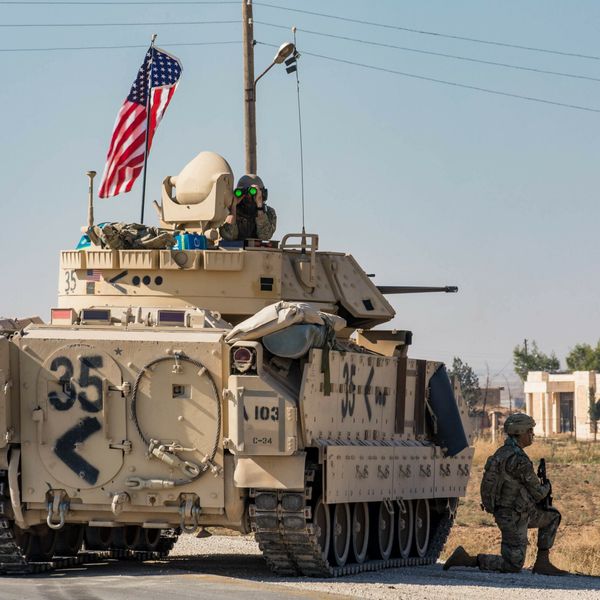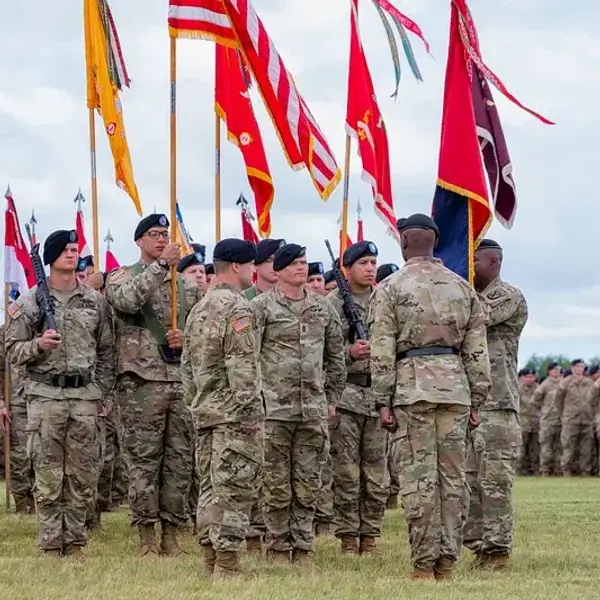Anyone can have a bad decade: the United States Navy has had four. It started in 1989. In April of that year, the number two turret on the battleship U.S.S. Iowa exploded, killing 47 crewmen. The Navy bungled the subsequent investigation, blaming the incident on a suicidal sailor they claimed was spurned by his male lover. It wasn't true: an independent inquiry cleared the sailor, saying the explosion was the likely result of a loading accident. When the sailor's family demanded an apology, the Navy refused.
Two years later, in September of 1991, during a "Tailhook" symposium of naval aviators at the Las Vegas Hilton Hotel, 26 Navy women were assaulted by some 70 male Navy and Marine pilots. The women were forced to run an alcohol-fueled "gauntlet" on the hotel's third floor, where they were "groped and grabbed" as they ran down a corridor.
The Navy again botched its inquiry, with one investigator claiming that "a lot of female pilots are go-go dancers, topless dancers or hookers." The Senate Armed Services Committee froze the promotion of 5,000 Navy and Marine officers, the Navy Secretary resigned, the Chief of Naval Operations retired early, and 14 admirals were reprimanded or forced to resign.
Then in 1996, Chief of Naval Operations Michael Boorda committed suicide after it was reported that he'd worn service ribbons he hadn't earned. Boorda's leadership was questioned after James Webb, the Secretary of the Navy, took aim at him during an address at the U.S. Naval Academy. Webb hounded Boorda, but had issues of his own — including penning an article entitled "Women Can't Fight."
The respite that followed lasted until 2010, when the Navy opened a fraud investigation of Leonard Glenn "Fat Leonard" Francis, a defense contractor who bribed Navy officers with prostitutes and cash to provide him with classified information that would help his company.
A series of unrelated, but embarrassing mishaps followed: in 2017, the USS Antietam ran aground in Tokyo Harbor, the USS Lake Champlain collided with a South Korean fishing boat, the USS Fitzgerald struck a Japanese merchant ship, and the USS John McCain slammed into an oil tanker.
The Fitzgerald and McCain collisions cost the lives of 17 sailors. More recently, in July of last year, Adm. Bill Moran — nominated to be the Chief of Naval Operations — retired after he exchanged emails with an aide accused of sexual misconduct. In November, Navy Secretary Richard Spencer was fired for "going outside the chain of command" in the case of Navy Seal Eddie Gallagher (accused of murdering a young Iraqi), while in April of this year, Spencer’s successor Thomas Modly resigned for mishandling the relief of Navy Captain Brent Crozier — and for issuing a profanity-laced tirade to the crew of Crozier's ship, the USS Theodore Roosevelt.
There's more. The U.S. Navy, as senior military observers note, is crippled by "cultural, behavioral and institutional issues," its deployments stained by "inadequate standards of seamanship and navigation," its operations marred by "confusion, equipment deficiencies, and lack of experience," its chain-of-command beset by "poor communications," while its special warfare personnel stand accused of child abuse, murder, sexual assault, drug addiction and lying to senior officers.
All of this could be fixed by "Big Navy" (the officers at the very top of the chain-of-command), except that, as one observer notes, they are infected with "an attitude of superiority and exceptionalism." But that attitude hasn't made the Navy's high command immune from a butcher's bill that includes the relief or forced retirement of a confirmed CNO, the head of the Navy War College, a Pacific Fleet commander, the head of Navy surface forces, the former leaders of the 5th and 7th Fleets, two task force commanders and the head of a destroyer squadron.
And so it is that the average American might ask the logical question: what in the world is wrong with the U.S. Navy?
The Navy, it seems, is asking the same question. On April 6, in the aftermath of the Crozier firing, Dr. Doyle Hodges, a former Navy commander and executive editor of the Texas National Security Review, penned a widely read critique of his former service's leadership. Citing the Navy's "recent, persistent, and self-inflicted wounds," Hodges portrayed the service as suffering from a "deficit" in "special trust and confidence."
Two weeks later, Naval Academy graduate and former destroyer captain Harlan Ullman wrote an influential article describing the service as "badly adrift," and suffering from "institutional, bureaucratic, cultural, ethical, and moral" problems. Ullman called for a "stem to stern review" of the service by "a separate panel of outside experts," presumably because the Navy is incapable of reviewing itself.
Crozier's relief also sparked a series of articles from former Navy officer Lawrence J. Korb, a senior fellow at the Center for American Progress, which slammed the Navy's chain-of-command and its new CNO for not defending the Roosevelt's captain. The stinging rebukes from a high profile triumvirate of former Navy officers resonated through the services's upper ranks, where the criticisms were interpreted as reflecting the views of the Navy's powerful retired senior officer community.
"The problem isn't inside the Navy's system," a retired high ranking Navy officer told me, "it's the system itself." The Navy operates the military's last caste structure, where entry into "Officer's Country" aboard ship is as carefully regulated now as it was when John Paul Jones captained the Bonhomme Richard during the American revolution. The importance of tradition seeps into every part of the service — and every part of a ship, where sailors regularly note that there are "different spanks for different ranks."
While there's been some easing up over the last decades, as a senior retired Navy officer told me, "the segregation between officers and enlisted subordinates is still strict — and antiquated. The sooner it's tossed overboard the better." Which is to say that while the applause from the Roosevelt crew that greeted the appearance of Capt. Brent Crozier was a testament to his popularity, it won him few friends among "Big Navy," and made not one whit of difference in determining his future.
But as Navy veteran Doyle Hodges points out, while rank confers privilege, it also exacts a price. "Command accountability in the Navy is also a tradition," he argues. "Because a commander has so much authority, the Navy holds him responsible. He's responsible for everything that happens on his ship, and has to answer for it. So when something happens, the tendency in the Navy is to ask 'alright, who was in charge?' — and to stop there, instead of looking at systemic issues that may also have contributed to the problem."
Hodges points out that while the Navy's traditions confer privilege they are also unforgiving, exacting personal accountability among senior officers. In the years between 2009 and 2014, a report in Stars and Stripes points out, 90 Navy commanders were relieved for "indiscretions" ranging from driving under the influence to having inappropriate relationships to being involved in collisions.
But just as Navy tradition underpins command accountability, the same traditions govern relations inside the service itself, with "blackshoe" surface officers competing for command slots with "brownshoe" aviators.
Submariners, the third of the Navy's "three pillars" this same officer told me, "are almost a separate service." Then too, Naval Academy graduates seem to have a lock on the service's top slot — the Chief of Naval Operations: 30 of the 32 CNOs were academy graduates (Michael Boorda and Vern Clark were not), while only three of thirty were submariners. That "Big Navy" is self-selecting is obvious, though often filled with surprises.
In July, then Navy Secretary Richard Spencer picked Vice Adm. Michael Gilday (a three star admiral) to succeed John Richardson as CNO, passing over seven four star candidates — the first time that had been done since 1970. Gilday's appointment spurred under-the-radar rumblings, particularly since his selection followed the retirement of Adm. William Moran, who was picked as Richardson's successor. But Moran took himself out of the job when it was revealed that he had solicited advice from former naval officer Chris Servello, who'd retired after being investigated for alleged sexual indiscretions.
The unexpected retirement of Moran threw "Big Navy" into chaos, as Moran was not only one of the most popular officers in recent Navy history, but a CNO who many believed would clean up the Navy's performance mess. What followed the retirement of Moran and the appointment of Gilday can only be described as chaos: Navy Secretary Richard Spencer, who chose Gilday, was summarily fired by Defense Secretary Mark Esper for "going outside the chain of command," with Thomas Modly chosen as his replacement — who was, in turn, dismissed after he relieved Brett Crozier as captain of the Roosevelt.
The head-spinning, trip-hammer chaos at the top of "Big Navy" — the unpredicted retirement of Moran, the firing of Spencer, the relief of Crozier and the firing of Modly — has inspired little confidence that the service is about to right itself. "You need a scorecard to keep track of this shit," a retired senior Navy officer told me in disgust. Korb agrees: "It's very unusual for a Secretary of the Navy to relieve a captain of a ship," he told me, "even if it's within his rights. And you have to remember, Modly had yet to be confirmed. He was Acting Secretary of the Navy."
But Korb, in reflecting his views in his widely circulated articles critiquing the decision, added that Crozier's firing "undermines the latitude a ship's captain has, and should have, in controlling his own ship and crew. And it calls into question the Navy's other long-held tradition: that tells senior officers that they'll be rewarded for speaking out about the Navy's problems. Now, it appears, speaking out can get you fired. It's a terrible, terrible precedent."
Surprisingly, however, the Navy's most deep-seated problems have little to do with either the Navy's staid traditions, or the turmoil inside "Big Navy." Rather, Pentagon officials say, the Navy is beset by a far deeper problem. "The Navy probably already spends too much of its time, effort, and resources maintaining a fixed deployment schedule," the Brookings Institution's Michael O'Hanlon wrote in April.
In plain English: the U.S. Navy has too many missions and too few sailors. The reason for that is that, in 2007, then-CNO Michael Mullen decided that the Navy would "augment" forces deployed in the so-called “war on terrorism” by assigning sailors to shore duties — in addition to their time at sea. The extra assignments imposed "a relentless operational tempo" on naval deployments and degraded fleet seamanship. The result is that some sailors are putting in 100 hour workweeks, while manning ships that are being required to meet punishing deployment schedules. That there have been collisions at sea is not a surprise, the senior Pentagon official with whom I spoke says, the surprise is that there haven't been more.
That judgment was confirmed in a 2019 ProPublica report that concluded that the Navy's 7th Fleet was "short of sailors" who were "worked to exhaustion." The fleet's warships were "falling apart" in the midst of "a bruising, ceaseless pace of operations," while "Big Navy" was "consumed with buying new, more sophisticated ships, even as its sailors struggled to master and hold together those they had." In the meantime, Donald Trump's airy call for a 350-ship Navy was met by nearly open rebellion by Navy leaders. Why would the Navy buy more ships when it is incapable of competently managing what it has? By April of 2020, something had to give. So when sailors of the USS Theodore Roosevelt came down with the coronavirus, Brett Crozier decided to push back against the "unrealistic demands" at the top of America's military establishment. He decided to defend his crew. In retrospect, "Big Navy's" response to Crozier was entirely predictable, and in keeping with the service's 244 year history.
They fired the messenger.
















